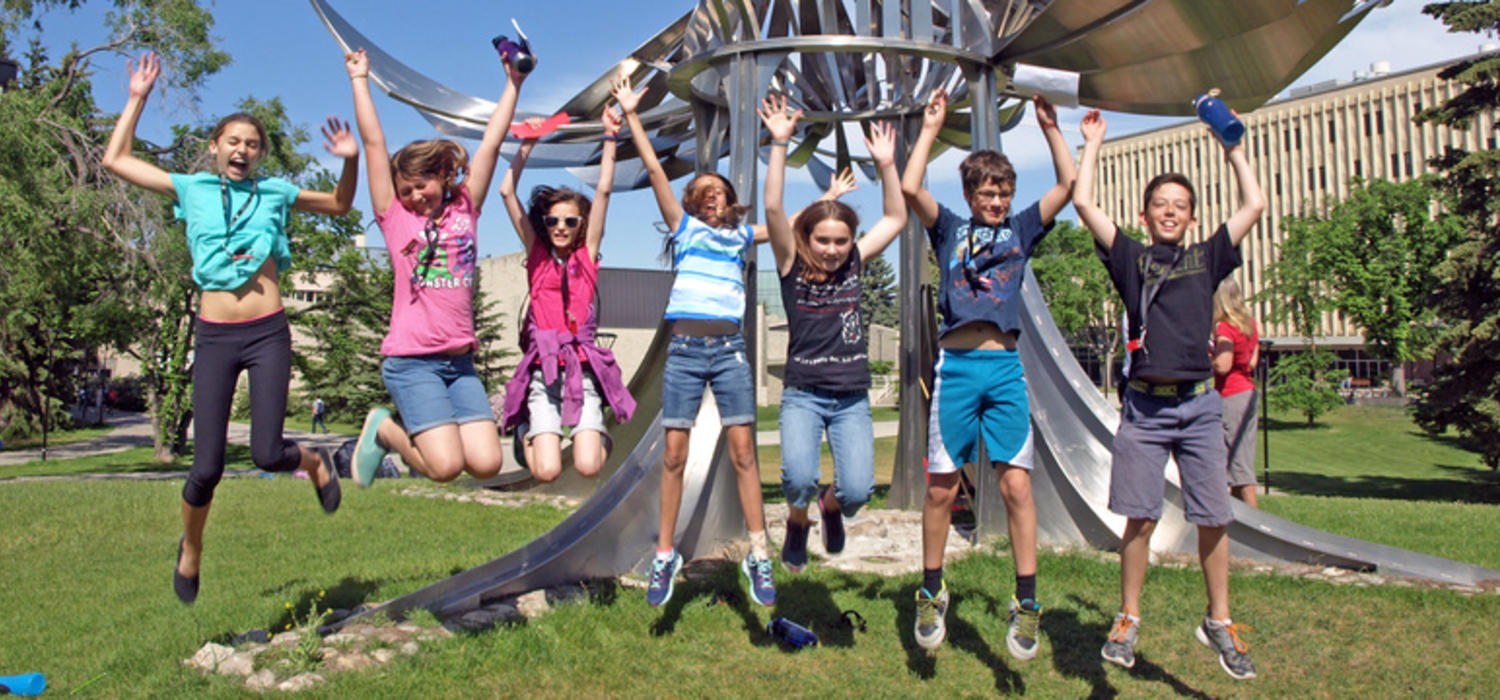June 22, 2015
Exploring the many benefits of learning a second language

Stuck to the edge of the long mural in the passageway between Mac Hall and Science B is a small piece of note paper, folded to hide the words written inside. A child’s hand reaches up to grasp the paper, the page is opened and a clue, written in Spanish, is revealed: “Estoy pintada de varios colores. Estoy cerca de muchas aceras. Los estudiantes pueden escribir encima de mi. ¿Te atreverías a levantarme? No creo que puedas, jajajaja!”
The race is on, as the team of Grade 6 students takes off for the destination described in the message.
That clue was part of a scavenger hunt organized for a group of 100 students from Calgary’s Senator Patrick Burns School, just one activity on campus in which they participated during a Spanish immersion camp held in early June.
(Clue translation: “I am painted various colours. I am surrounded by sidewalks. Students can write on me. I dare you to try and lift me. I don’t think you can, hahaha!)
Learning to speak a new language is only half the challenge
There are all sorts of reasons to learn an additional language: better job opportunities, an increased capacity to communicate with people from another culture, connecting with your heritage, ease in travel, even the possibility that being fluent in two or more languages may play a part in staving off dementia.
Not things a 12 year old thinks too much about.
But teacher Laura Groulik wants to get her Spanish immersion students into that mindset. The Grade 6 teacher at Senator Patrick Burns says she wants her students to realize that learning Spanish has the potential to pay off in many ways as they continue their education.
“There are people in Calgary who, as adults, wish they could have learned a language earlier on in their life,” says Groulik who earned her BA in Spanish and French at the University of Calgary in 2005 and her teaching degree at the Werklund School of Education in 2009. “There are many possibilities for those who pursue learning a second language.”
One of the challenges in teaching students a second language is that there is a fairly high level of attrition; just around the time students enter high school, they tend to drop their second language studies.
So colleagues Laura Groulik and Carlotta Carr decided to do something about it. Collaborating with four Werklund undergrad students on practicum in Spanish immersion classes in various Calgary schools, both teachers decided to host a “Spanish Conference” on the campus of the University of Calgary to expose their students to authentic learning experiences over a two day period in early June. “Often, field trips offered — even in a bilingual setting — are English-based,” Groulik explains. "This was the very first overnight field trip to be entirely done in Spanish.”
Two-day program was immersive, intensive, and fun
During the conference, the students took part in workshops that included the scavenger hunt, some time in the gym and on stage in the theatre, and even included an overnight stay at Kananaskis Hall.
The underlying concept of the conference was for the students to discover that they can take their acquired and practiced skills out of the classroom and put them to use in a variety of different situations.
“The importance of practising spontaneous Spanish is fundamental to the success of the bilingual program,” says Groulik. “It is not enough to simply answer grammar questions or complete projects if you cannot speak the language.”
Werklund students key to the conference
The four Werklund students — Jordan Hannam, Monica Zarco, Courtney Keen and Maikala Harris — all see the benefits in engaging the students now, and opening their eyes to the possibilities a post-secondary institution offers.
Says Zarco: “There are times when second language learning in a classroom can be challenging, because students sometimes struggle to see how they can use Spanish to communicate in their own city.”
“I think the campus is the ideal setting because one day some of these students will attend the University of Calgary and giving them access to this space allows them a glimpse into their futures and permits them to experience speaking Spanish in a setting outside of their own classroom.”
Hannam agrees and says her hope is that the students learned that second language acquisition has a purpose outside the classroom, and that learning language is more than memorizing vocabulary and learning grammatical structures. “Languages open doors in every way possible for people who learn them.”
“I hope the students see that their hard work and dedication to the Spanish language has a purpose and potential outside of the classroom walls.”
Lessons learned by Werklund students too
All four of the Werklund students earned their BEd degrees earlier this month, and they say it wasn’t just the junior high students who picked up some important lessons.
Hannam says that she’s learned that patience and encouragement are keys to learning a second language. “As a new teacher I have learned that acquiring a second language requires constant practice and reinforcement.”
“The students want to know that their learning is purposeful,” says Zarco. “I have learned that leveraging one’s community and engaging community members in public education is crucial to creating memorable learning experiences for students."
For her part, Groulik says working with the Werklund undergrads was a great experience. “These students are extremely creative, dynamic and patient young future Spanish teachers.”
“They have been able to adapt to any situation and come up with fun and interactive experiences that they know will be relevant to the lives of the grade six students.”
